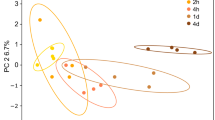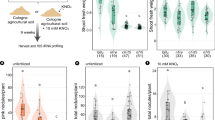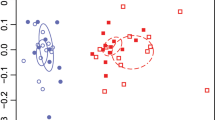Abstract
Like all higher organisms, plants have evolved in the context of a microbial world, shaping both their evolution and their contemporary ecology. Interactions between plant roots and soil microorganisms are critical for plant fitness in natural environments. Given this co-evolution and the pivotal importance of plant–microbial interactions, it has been hypothesized, and a growing body of literature suggests, that plants may regulate the composition of their rhizosphere to promote the growth of microorganisms that improve plant fitness in a given ecosystem. Here, using a combination of comparative genomics and exometabolomics, we show that pre-programmed developmental processes in plants (Avena barbata) result in consistent patterns in the chemical composition of root exudates. This chemical succession in the rhizosphere interacts with microbial metabolite substrate preferences that are predictable from genome sequences. Specifically, we observed a preference by rhizosphere bacteria for consumption of aromatic organic acids exuded by plants (nicotinic, shikimic, salicylic, cinnamic and indole-3-acetic). The combination of these plant exudation traits and microbial substrate uptake traits interact to yield the patterns of microbial community assembly observed in the rhizosphere of an annual grass. This discovery provides a mechanistic underpinning for the process of rhizosphere microbial community assembly and provides an attractive direction for the manipulation of the rhizosphere microbiome for beneficial outcomes.
This is a preview of subscription content, access via your institution
Access options
Access Nature and 54 other Nature Portfolio journals
Get Nature+, our best-value online-access subscription
$29.99 / 30 days
cancel any time
Subscribe to this journal
Receive 12 digital issues and online access to articles
$119.00 per year
only $9.92 per issue
Buy this article
- Purchase on Springer Link
- Instant access to full article PDF
Prices may be subject to local taxes which are calculated during checkout






Similar content being viewed by others
References
Hiltner, L. Über neuere erfahrungen und probleme auf dem gebiete der bodenbakteriologie unter besonderer berücksichtigung der gründüngung und brache. Arb. DLG 98, 59–78 (1904).
Shi, S. et al. Successional trajectories of rhizosphere bacterial communities over consecutive seasons. mBio 6, e00746 (2015).
Chaparro, J. M., Badri, D. V. & Vivanco, J. M. Rhizosphere microbiome assemblage is affected by plant development. ISME J. 8, 790–803 (2013).
Chaparro, J. M. et al. Root exudation of phytochemicals in Arabidopsis follows specific patterns that are developmentally programmed and correlate with soil microbial functions. PLoS ONE 8, e55731 (2013).
Bulgarelli, D. et al. Revealing structure and assembly cues for Arabidopsis root-inhabiting bacterial microbiota. Nature 488, 91–95 (2012).
Grayston, S. J., Wang, S., Campbell, C. D. & Edwards, A. C. Selective influence of plant species on microbial diversity in the rhizosphere. Soil Biol. Biochem. 30, 369–378 (1998).
Peiffer, J. A. et al. Diversity and heritability of the maize rhizosphere microbiome under field conditions. Proc. Natl Acad. Sci. USA 110, 6548–6553 (2013).
DeAngelis, K. M. et al. Selective progressive response of soil microbial community to wild oat roots. ISME J. 3, 168–178 (2009).
Lundberg, D. S. et al. Defining the core Arabidopsis thaliana root microbiome. Nature 488, 86–90 (2012).
Lu, Y., Rosencrantz, D., Liesack, W. & Conrad, R. Structure and activity of bacterial community inhabiting rice roots and the rhizosphere. Environ. Microbiol. 8, 1351–1360 (2006).
Bulgarelli, D. et al. Structure and function of the bacterial root microbiota in wild and domesticated barley. Cell Host Microbe 17, 392–403 (2015).
Schreiter, S. et al. Effect of the soil type on the microbiome in the rhizosphere of field-grown lettuce. Front. Microbiol. 5, 144 (2014).
Pini, F., Galardini, M., Bazzicalupo, M. & Mengoni, A. Plant–bacteria association and symbiosis: are there common genomic traits in Alphaproteobacteria? Genes (Basel) 2, 1017–1032 (2011).
Badri, D. V., Chaparro, J. M., Zhang, R., Shen, Q. & Vivanco, J. M. Application of natural blends of phytochemicals derived from the root exudates of Arabidopsis to the soil reveal that phenolic-related compounds predominantly modulate the soil microbiome. J. Biol. Chem. 288, 4502–4512 (2013).
Shi, S. et al. Effects of selected root exudate components on soil bacterial communities. FEMS Microbiol. Ecol. 77, 600–610 (2011).
Lebeis, S. L. et al. Plant microbiome. Salicylic acid modulates colonization of the root microbiome by specific bacterial taxa. Science 349, 860–864 (2015).
Lynch, J. M. & Whipps, J. M. Substrate flow in the rhizosphere. Plant Soil 129, 1–10 (1990).
Badri, D. V. & Vivanco, J. M. Regulation and function of root exudates. Plant Cell Environ. 32, 666–681 (2009).
Baetz, U. & Martinoia, E. Root exudates: the hidden part of plant defense. Trends Plant Sci. 19, 90–98 (2014).
Bais, H. P., Weir, T. L., Perry, L. G., Gilroy, S. & Vivanco, J. M. The role of root exudates in rhizosphere interactions with plants and other organisms. Annu. Rev. Plant Biol. 57, 233–266 (2006).
Aulakh, M. S., Wassmann, R., Bueno, C., Kreuzwieser, J. & Rennenberg, H. Characterization of root exudates at different growth stages of ten rice (Oryza sativa L.) cultivars. Plant Biol. 3, 139–148 (2001).
Jones, D. L. Organic acids in rhizosphere—a critical review. Plant Soil 205, 25–44 (1998).
Iannucci, A., Fragasso, M., Platani, C. & Papa, R. Plant growth and phenolic compounds in the rhizosphere soil of wild oat (Avena fatua L.). Front. Plant Sci. 4, 509 (2013).
Dakora, F. D. & Phillips, D. A. in Food Security in Nutrient-Stressed Environments: Exploiting Plants’ Genetic Capabilities (ed. Adu-Gyamfi, J. J.) 201–213 (Springer, Dordrecht, 2002). https://doi.org/10.1007/978-94-017-1570-6_23.
Bulgarelli, D., Schlaeppi, K., Spaepen, S., van Themaat, E. V. L. & Schulze-Lefert, P. Structure and functions of the bacterial microbiota of plants. Annu. Rev. Plant Biol. 64, 807–838 (2013).
Hassan, S. & Mathesius, U. The role of flavonoids in root-rhizosphere signalling: opportunities and challenges for improving plant–microbe interactions. J. Exp. Bot. 63, 3429–3444 (2012).
Corral-Lugo, A., Daddaoua, A., Ortega, A., Espinosa-Urgel, M. & Krell, T. Rosmarinic acid is a homoserine lactone mimic produced by plants that activates a bacterial quorum-sensing regulator. Sci. Signal. 9, ra1 (2016).
Huang, X.-F. et al. Rhizosphere interactions: root exudates, microbes, and microbial communities 1. Botany 92, 267–275 (2014).
Beauregard, P. B., Chai, Y., Vlamakis, H., Losick, R. & Kolter, R. Bacillus subtilis biofilm induction by plant polysaccharides. Proc. Natl Acad. Sci. USA 110, E1621–E1630 (2013).
Cai, T. et al. Host legume-exuded antimetabolites optimize the symbiotic rhizosphere. Mol. Microbiol. 73, 507–517 (2009).
Silva, L. P. & Northen, T. R. Exometabolomics and MSI: deconstructing how cells interact to transform their small molecule environment. Curr. Opin. Biotechnol. 34, 209–216 (2015).
Baran, R. et al. Exometabolite niche partitioning among sympatric soil bacteria. Nat. Commun. 6, 8289 (2015).
Mao, Y., Li, X., Smyth, E. M., Yannarell, A. C. & Mackie, R. I. Enrichment of specific bacterial and eukaryotic microbes in the rhizosphere of switchgrass (Panicum virgatum L.) through root exudates. Environ. Microbiol. Rep. 6, 293–306 (2014).
Chisholm, S. T., Coaker, G., Day, B. & Staskawicz, B. J. Host–microbe interactions: shaping the evolution of the plant immune response. Cell 124, 803–814 (2006).
Souza, R., de Ambrosini, A. & Passaglia, L. M. P. Plant growth-promoting bacteria as inoculants in agricultural soils. Genet. Mol. Biol. 38, 401–419 (2015).
Lambers, H., Mougel, C., Jaillard, B. & Hinsinger, P. Plant–microbe–soil interactions in the rhizosphere: an evolutionary perspective. Plant Soil 321, 83–115 (2009).
Roller, B. R. K., Stoddard, S. F. & Schmidt, T. M. Exploiting rRNA operon copy number to investigate bacterial reproductive strategies. Nat. Microbiol. 1, 16160 (2016).
Neumann, G. & Römheld, V. in The Rhizosphere (eds Pinton, R. et al.) 23–72 (CRC Press, Boca Raton, 2009).
Walker, T. S., Bais, H. P., Grotewold, E. & Vivanco, J. M. Root exudation and rhizosphere biology. Plant Physiol. 132, 44–51 (2003).
Salerno, G. Origin of sucrose metabolism in higher plants: when, how and why? Trends Plant Sci. 8, 63–69 (2003).
Jaeger, C., Lindow, S., Miller, W., Clark, E. & Firestone, M. Mapping of sugar and amino acid availability in soil around roots with bacterial sensors of sucrose and tryptophan. Appl. Environ. Microbiol. 65, 2685–2690 (1999).
Vargas, W. A., Mandawe, J. C. & Kenerley, C. M. Plant-derived sucrose is a key element in the symbiotic association between Trichoderma virens and maize plants. Plant Physiol. 151, 792–808 (2009).
Lemoine, R. et al. Source-to-sink transport of sugar and regulation by environmental factors. Front. Plant Sci. 4, 272 (2013).
Lattanzio, V. & Lattanzio, V. in Phytochemistry: Advances in Research (ed. Imperato, F.) 23–67 (Research Signpost, Kerala, 2006).
Iqbal, N., Nazar, R. & Khan, N. A. (eds) Osmolytes and Plants Acclimation to Changing Environment: Emerging Omics Technologies (Springer, New York, 2015).
Noodén, L. D. (ed.) in Senescence and Aging in Plants 329–368 (Elsevier, Cambridge, MA, 1988). https://doi.org/10.1016/B978-0-12-520920-5.50016-X.
Brown, J. H., Paliyath, G. & Thompson, J. E. in Plant Physiology (ed. Steward, F. C.) 227–276 (Academic Press, San Diego, CA, 1991). https://doi.org/10.1111/j.1399-3054.1981.tb08516.x/full.
Mueller-Roeber, B. & Balazadeh, S. Auxin and its role in plant senescence. J. Plant Growth Regul. 33, 21–33 (2013).
Pilet, P.-E. & Saugy, M. Effect on root growth of endogenous and applied IAA and ABA: a critical reexamination. Plant Physiol. 83, 33–38 (1987).
Ramachandran, V. K., East, A. K., Karunakaran, R., Downie, J. A. & Poole, P. S. Adaptation of Rhizobium leguminosarum to pea, alfalfa and sugar beet rhizospheres investigated by comparative transcriptomics. Genome Biol. 12, R106 (2011).
Lugtenberg, B. J. J., Kravchenko, L. V. & Simons, M. Tomato seed and root exudate sugars: composition, utilization by Pseudomonas biocontrol strains and role in rhizosphere colonization. Environ. Microbiol. 1, 439–446 (1999).
Lugtenberg, B. J., Dekkers, L. & Bloemberg, G. V. Molecular determinants of rhizosphere colonization by Pseudomonas. Annu. Rev. Phytopathol. 39, 461–490 (2001).
Blakley, E. R. & Simpson, F. J. The microbial metabolism of cinnamic acid. Can. J. Microbiol. 10, 175–185 (1964).
Yuan, J. et al. Organic acids from root exudates of banana help root colonization of PGPR strain Bacillus amyloliquefaciens NJN-6. Sci. Rep. 5, 13438 (2015).
Lowe-Power, T. M. et al Degradation of the plant defense signal salicylic acid protects Ralstonia solanacearum from toxicity and enhances virulence on tobacco. mBio 7, e00656-16 (2016).
Nuccio, E. E. et al. Climate and edaphic controllers influence rhizosphere community assembly for a wild annual grass. Ecology 97, 1307–1318 (2016).
Nunes da Rocha, U. et al. Isolation of a significant fraction of non-phototroph diversity from a desert biological soil crust. Front. Microbiol. 6, 277 (2015).
McGinnis, S. & Madden, T. L. BLAST: at the core of a powerful and diverse set of sequence analysis tools. Nucleic Acids Res. 32, W20–W25 (2004).
Edgar, R. C. MUSCLE: multiple sequence alignment with high accuracy and high throughput. Nucleic Acids Res. 32, 1792–1797 (2004).
Vieira-Silva, S. & Rocha, E. P. C. The systemic imprint of growth and its uses in ecological (meta)genomics. PLoS Genet. 6, e1000808 (2010).
Subramanian, S. Nearly neutrality and the evolution of codon usage bias in eukaryotic genomes. Genetics 178, 2429–2432 (2008).
Lombard, V., Golaconda Ramulu, H., Drula, E., Coutinho, P. M. & Henrissat, B. The carbohydrate-active enzymes database (CAZy) in 2013. Nucleic Acids Res. 42, D490–D495 (2014).
Yin, C., Li, S. & Li, Q. Network traffic classification via HMM under the guidance of syntactic structure. Comput. Netw. 56, 1814–1825 (2012).
Ren, Q., Chen, K. & Paulsen, I. T. TransportDB: a comprehensive database resource for cytoplasmic membrane transport systems and outer membrane channels. Nucleic Acids Res. 35, D274–D279 (2007).
Price, M. N., Dehal, P. S. & Arkin, A. P. FastTree 2—approximately maximum-likelihood trees for large alignments. PLoS ONE 5, e9490 (2010).
Murashige, T. & Skoog, F. A revised medium for rapid growth and bio assays with tobacco tissue cultures. Physiol. Plant. 15, 473–497 (1962).
Khorassani, R. et al. Citramalic acid and salicylic acid in sugar beet root exudates solubilize soil phosphorus. BMC Plant. Biol. 11, 121 (2011).
Pluskal, T., Castillo, S., Villar-Briones, A. & Orešič, M. MZmine 2: modular framework for processing, visualizing, and analyzing mass spectrometry-based molecular profile data. BMC Bioinformatics 11, 395 (2010).
Bowen, B. P. & Northen, T. R. Dealing with the unknown: metabolomics and metabolite atlases. J. Am. Soc. Mass. Spectrom. 21, 1471–1476 (2010).
Smith, C. A. et al. METLIN: a metabolite mass spectral database. Ther. Drug. Monit. 27, 747–751 (2005).
Horai, H. et al. MassBank: a public repository for sharing mass spectral data for life sciences. J. Mass Spectrom. 45, 703–714 (2010).
Sumner, L. W. et al. Proposed minimum reporting standards for chemical analysis. Metabolomics 3, 211–221 (2007).
R: A Language and Environment for Statistical Computing (R Development Core Team, 2017); www.R-project.org.
vegan: community ecology package. R package version 2.4-2 (Blanchet, F. G. et al., 2017); https://CRAN.R-project.org/package=vegan.
agricolae: statistical procedures for agricultural research. R package version 1.2-4 (de Mendiburu, F., 2016); https://CRAN.R-project.org/package=agricolae.
Mevik, B.-H. & Wehrens, R. The plsPackage: principal component and partial least squares regression in R. J. Stat. Softw. 18, 1–23 (2007).
Acknowledgements
This study was supported by the DOE, Office of Science, Office of Biological Environmental Research, including a Genomic Sciences programme award no. DE-SC0010570, DE-SC0016247 and DE-SC0014079 to M.K.F. Work performed at the Lawrence Berkeley National Laboratory including DOE Early Career Awards to D.L. and T.R.N., and work performed at the DOE JGI (http://www.jgi.gov) and at the DOE Joint BioEnergy Institute (http://www.jbei.org) are supported by the DOE, Office of Science, Office of Biological and Environmental Research through Contract No. DE-AC02-05CH11231. D.L. was also supported in part by the European Union’s Horizon 2020 research and innovation programme under the Marie Sklodowska-Curie grant agreement no. 659910. Isolate genome sequencing was conducted by the DOE JGI, a DOE Office of Science User Facility, under a Community Science Program award to E.L.B., supported by the Office of Science of the DOE under Contract no. DE-AC02-05CH11231. We thank C. Castanha for background information on soil temperature and are very grateful to our talented former undergraduate students B. Jargalsaikhan, R. Hossainkhil, D. Ly, S. Ouedraogo and Y. Nguyen for their assistance with maintenance of the bacterial isolate collection.
Author information
Authors and Affiliations
Contributions
K.Z., T.R.N., M.K.F. and E.L.B. developed the hypotheses. K.Z., K.B.L., N.M., U.N.d.R., S.S. and D.L. performed the experimental analyses. K.Z., H.C., U.K., Z.H., U.N.d.R. and B.P.B. analysed the data. K.Z., T.R.N., M.K.F. and E.L.B. wrote the paper. All authors provided comments and edits on the manuscript.
Corresponding authors
Ethics declarations
Competing interests
The authors declare no competing interests.
Additional information
Publisher’s note: Springer Nature remains neutral with regard to jurisdictional claims in published maps and institutional affiliations.
Supplementary information
Supplementary Information
Supplementary Methods, Supplementary Tables 1 & 2 and Supplementary Figures 1–14.
Supplementary Data Set 1
Additional details on bacterial isolates described in the text, their genome identifiers and their observed response to root growth.
Supplementary Data Set 2
Additional details on transporters and CAZy enzymes identified in the genomes of isolates described in the text, their gene identifiers, classification and differences in their distributions between rhizosphere positive and negative responders.
Supplementary Data Set 3
Additional details on identification of metabolites in Avena barbata exudation described in the text, their theoretical and measured m/z, retention times and relative abundances at different time points of plant growth.
Supplementary Data Set 4
Additional details on identification of metabolites consumed by isolates from Avena barbata exudates described in the text, their theoretical and measured m/z, retention times and differences in uptake between rhizosphere positive and negative responders.
Supplementary Data Set 5
Additional details on prediction of isolate response to root growth based on exometabolite profiles that were used to build a principal component regression (PCR) model.
Rights and permissions
About this article
Cite this article
Zhalnina, K., Louie, K.B., Hao, Z. et al. Dynamic root exudate chemistry and microbial substrate preferences drive patterns in rhizosphere microbial community assembly. Nat Microbiol 3, 470–480 (2018). https://doi.org/10.1038/s41564-018-0129-3
Received:
Accepted:
Published:
Issue Date:
DOI: https://doi.org/10.1038/s41564-018-0129-3
This article is cited by
-
Bacterial community structure and co-occurrence networks in the rhizosphere and root endosphere of the grafted apple
BMC Microbiology (2024)
-
OsCIPK2 mediated rice root microorganisms and metabolites to improve plant nitrogen uptake
BMC Plant Biology (2024)
-
Unraveling the interplay between root exudates, microbiota, and rhizosheath formation in pearl millet
Microbiome (2024)
-
Sphingobium sp. V4, a bacterium degrading multiple allelochemical phenolic acids
Annals of Microbiology (2024)
-
Plant effects on microbiome composition are constrained by environmental conditions in a successional grassland
Environmental Microbiome (2024)



